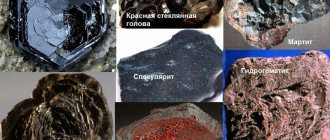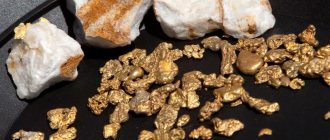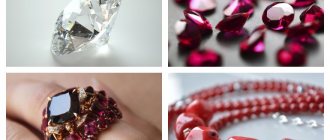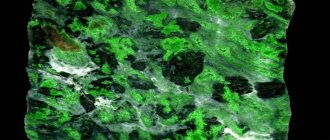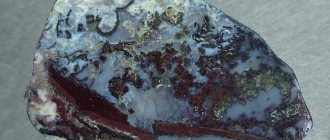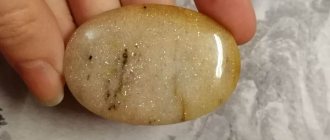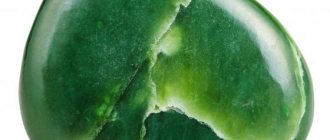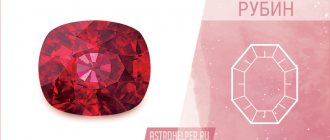| Category | Borates (minerals) |
| Title in English | Howlite |
| Formula | Ca2SiB5O9(OH)5 |
| Group | Group of Gems |
| Color | White, Colorless, Yellow, Brown |
| Stroke color | White |
| Shine | Glass, Silky |
| Transparency | Opaque, Transparent |
| singonia | Monoclinic |
| Hardness | 3,5 |
| Cleavage | Absent |
| Density, g/cm³ | 2,5 — 2,6 |
| Kink | Smooth |
| origin of name | The man who discovered the Howlite mineral was a Canadian-born geologist, Henry Gove. The word howlite itself is formed from the surname of the geologist Gov and the Greek word λίθος is added to it, which translates as “stone”. It turns out to be “Gova stone”. By nature, the mineral has a characteristic white color, but if you paint it blue, you get an imitation of turquoise. Thanks to this, howlite received another name - pressed turquoise. |
| Morphology | Howlite crystals have a tabular appearance. Most often, the mineral is found in the form of radial aggregates, nodules and porcelain-like nodules. |
The mineral howlite is also known in mineralogy under such names as silicoborocalcite, caulite, turquenite or turkenite. Today it is a rare, but still affordable and quite popular stone in jewelry. He is also the patron saint of all students. Its natural specimens are quite inconspicuous - painted white, gray or black, but howlite is often given an artificial color, and in this form the gem is even used as an imitation for more expensive precious and semi-precious stones.
Howlite deposits
In nature, howlite deposits are quite rare. The process of formation of this mineral takes place in special pools during the precipitation of salt solutions that contain a high percentage of calcium and boron. Its largest deposits are located in the USA and California. Deposits of howlite of medium size are found in mines in Serbia and Germany. Clusters of plate-shaped howlite crystals were discovered in Canada.
History of howlite
— Advertising —
The howlite mineral was first discovered in eastern Canada (Nova Scotia Peninsula). This unusual name was given to the stone after its discoverer, geologist G. Gova.
In modern mineralogy, howlite is also found under the names “caulite” and “turquenite”. The last of these appeared about half a century ago and is usually used as a designation for blue-blue howlite. Very often, this mineral is also called “pressed turquoise,” especially when used in the manufacture of jewelry. But howlite has nothing to do with natural turquoise.
Description of varieties
Absorbs dyes
Varieties of howlite differ in color. Turquenite is a white stone with a slight blue tint; sometimes the name sounds like turkenite, which is also correct. The grayish mineral is called caulite. Both types are characterized by the presence of small holes that look like pores. They create a sort of mesh structure on the surface.
This property allows howlite to absorb dyes well. Considering the not very attractive appearance of natural minerals from a jewelry point of view, people have come up with the idea of making imitation of more expensive stones from them.
Creation of "turquoise"
By painting green or blue colors, “turquoise” is created. Natural reserves of this beautiful stone are decreasing. Details in the article “Turquoise stone: properties and who it suits according to their zodiac sign.”
Turkvenites, after changing color, are hardly distinguishable from real jewelry. Having acquired bright turquoise tones, they, like turquoise, remain lined with thin black threads.
But there is an important difference between white howlite (turquinite) and turquoise. The hardness of the first mineral is half that of the second. This means that howlite may well be damaged if dropped, cracked or scratched. An indicator of 3.5 units does not provide reliable strength. For a radical test, heat is used. At the same time, natural turquoise cracks, and turkenite turns black and melts.
Imitation coral
Another common way to use howlite is to create imitation corals. For this purpose red paint is used. Here, hardness is inversely related, since corals are “softer” than howlite by a whole unit.
The paint applies to howlite so smoothly that even jewelers are not always able to distinguish a fake. Alcohol helps here. You need to wet the cotton wool and wipe the surface of the stone. If a pink-red mark remains, then the stone is painted and may be howlite.
However, the corals themselves are often tinted. Therefore, in order not to make a mistake when buying jewelry, it is better to contact a gemologist or an experienced craftsman. The article “All about corals: properties and meaning of the stone” will tell you more about stones of organic origin.
Physico-chemical characteristics of howlite
According to the characteristics of the chemical composition, howlite is calcium borosilicate. The most common crystal colors include white and shades of gray. In addition, there are specimens decorated with inclusions and veins of black and brown shades. It is easy to artificially give howlite a blue color. Howlite crystals have a silky shine. Their hardness on the Mohs scale is 3.5, specific gravity is 2.5-2.6 g/cm3.
Jewelry with mineral
Howlite is a jewelry stone from which talismans and amulets are made. It is worn by people who respect the good qualities in themselves. Under any circumstances, it helps to maintain dignity, and also supports the owner’s character and gives the individual self-confidence.
Jewelry - talismans are made from a white variety of natural mineral. Once sanded and shaped into the desired shape, it is ready to be carried in your bag, pocket, or to decorate your desk.
In particular, this is an amulet for dentists who keep stones in their office. It is believed that it makes the speech kind and the hand light, which is important for a specialist of this profile. And also professionalism is constantly improving. People of many other professions also purchase Howlite as their amulet.
The use of gems in jewelry involves the creation of a variety of crafts. The price of products made from this semi-precious stone is not very high and is available to everyone. The white variety is a material for creating luxurious jewelry.
Also read: Sphene – shining like a diamond
The compatibility of the mineral with metals: silver, gold allows you to make original jewelry for all occasions. Jewelers love Howlite, which is combined in various colors and shades in costume jewelry. It is used to make beads, bracelets, decorative items for interiors, and figurines.
Thus, jewelry made from natural stones (Howlita) costs from 400 rubles for earrings to 1,500 rubles for bracelets. Items with ion plating made of rose gold can cost up to 8,000 rubles.
Magical properties of howlite
— Advertising —
Howlite, painted pure white, is a symbol of purity and innocence. At the same time, it also personifies strength and human dignity. Jewelry containing elements made of white howlite softens anger, eliminates anxiety and fear, bad thoughts and feelings.
In addition, howlite is widely popular among those involved in dream interpretation. The stone itself helps to remember dreams.
But its main advantage and feature is considered to be powerful support in acquiring various skills and knowledge. No wonder howlite is known as the patron saint of students. The mineral promotes concentration in the study of sciences, helps to master them easily and comfortably. It perfectly helps its owners during interviews, tests and exams. It makes it easy to make a good impression on examiners or employers. This stone also promotes the owner’s desire for constant self-improvement. Those who use howlite jewelry and talismans become a kind of “eternal students”, intellectuals, and constantly strive to gain new knowledge in all industries and fields of activity.
What stones does it go with?
Most often, when craftsmen create jewelry from howlite, they are not guided by any superstitions or signs. These professionals look at color combinations.
Since white is a very unique color, any other shade can be paired harmoniously with it. It easily fits into the company and is repainted green.
Only emerald color is not suitable for him as a friend. Much worse things consist of howlite disguised as coral. He does not go well with any colors, so finding a companion for him will not be easy at all.
The healing properties of howlite
The mineral howlite has a good effect on the condition of bones and joints.
This is due to the fact that it contains a high percentage of calcium. With the help of the stone, the healing of fractures is accelerated, and an optimal level of calcium is maintained in the body. For this reason, howlite jewelry and talismans are recommended for all pregnant women to prevent the occurrence of a deficiency of this element. In addition, howlite promotes dental health and helps in eliminating toothache. Beads and necklaces made of howlite have a positive effect on the cardiovascular system and increase resistance in stressful situations.
Howlite has also found use among massage therapists due to its high heat capacity. Massages are performed with it to get rid of cellulite, varicose veins and various joint diseases.
Physical Features
It has a radial-radial structure and comes in various volumes and configurations. Also, its structure is porous.
It is often colored according to the unattractiveness factor of the natural appearance type. Green and blue colors are used to imitate turquoise. At the same time, even experts doubt that they can recognize a fake. The coloring is also done in red depending on the type of coral.
How to distinguish real howlite from a fake
Howlite is not faked, since this stone is inexpensive, despite its rarity. But the mineral itself can be painted in other colors, and such specimens are used as an imitation for other stones. For example, blue and blue-green howlites are used as a counterfeit of turquoise. It is extremely difficult to distinguish it and is only possible in a specialized laboratory. When howlite is painted in shades of red, it closely resembles expensive corals.
How to care
Howlite requires special care due to its physical characteristics - low hardness and porous structure:
- It should be stored in an opaque, tightly closed box or box.
- You should not wear jewelry with howlite to the pool, sauna, beach or while doing housework.
- They are also not suitable for long summer walks, since the stone does not tolerate the sun.
- Wash the mineral only with warm water, as the slightest chemical can cause it to lose its color or even collapse.
Howlite and zodiac sign
Astrologers identify the following zodiac signs for which howlite is recommended as a talisman: Taurus, Scorpio, Virgo and Capricorn.
All these zodiac signs immediately begin to feel the positive influence of the mineral. It is manifested by the development of perseverance in achieving desired goals and patience towards others. It is also important to remember that there are zodiac signs for whom howlite gem is categorically contraindicated. These include Sagittarius, Aries and Leo. For them, the mineral can only bring sadness and disappointment.
Representatives of other zodiac signs can use howlite without fear of negative consequences. This generally calm mineral rarely causes harm, and even if it does not help, it remains neutral towards its owner.
Turkvenite and turquoise
The reserves of turquoise on earth are almost depleted. For reference, here is an example. The best turquoise on earth was and is mined in Iran near the city of Nishapur. So, in the early 70s of the last century, the annual production of turquoise at this deposit was 300 tons per year. And in 2010 there were only 30 tons. The demand for this mineral is invariably high. Interest in turquoise has never disappeared and is unlikely to disappear. This is a very beautiful stone in jewelry. A product with turquoise is expensive, and prices for natural turquoise will only rise.
That is why turquoise-colored howlite, or turquenite, came in handy. If you are not a “pro,” you are unlikely to be able to visually distinguish turquenite from turquoise. This product looks bright, attractive, and delights the eye with its magnificent azure. But if you take a closer look, and even armed with a magnifying glass, you can find the difference:
• after painting and polishing, turquenite shines like a porcelain figurine; • turquoise has a noble deep matte finish, and it never shines; • looking at turquenite through a magnifying glass, you can see small crystals, which is not even a trace of turquoise.
To be fair, it must be said that not only howlite is dressed up as turquoise, but also the mineral magnesite, or more precisely, magnesium carbonate. It is also painted turquoise, polished and widely used to imitate this noble stone. The natural color of the magnesite mineral, magnesium carbonate, is light gray, yellowish or brown. It has a glassy luster, is transparent and fragile. Even colored magnesite is easily distinguishable from true turquoise. Magnesite is similar to turquoise, like the cartoon Piggy to a real pig. It is better to make a fake of it from turquenite. This is not our opinion, but that of those who dishonestly pass off a fake stone as a real one. Moreover, this stone costs much less than a noble mineral.

